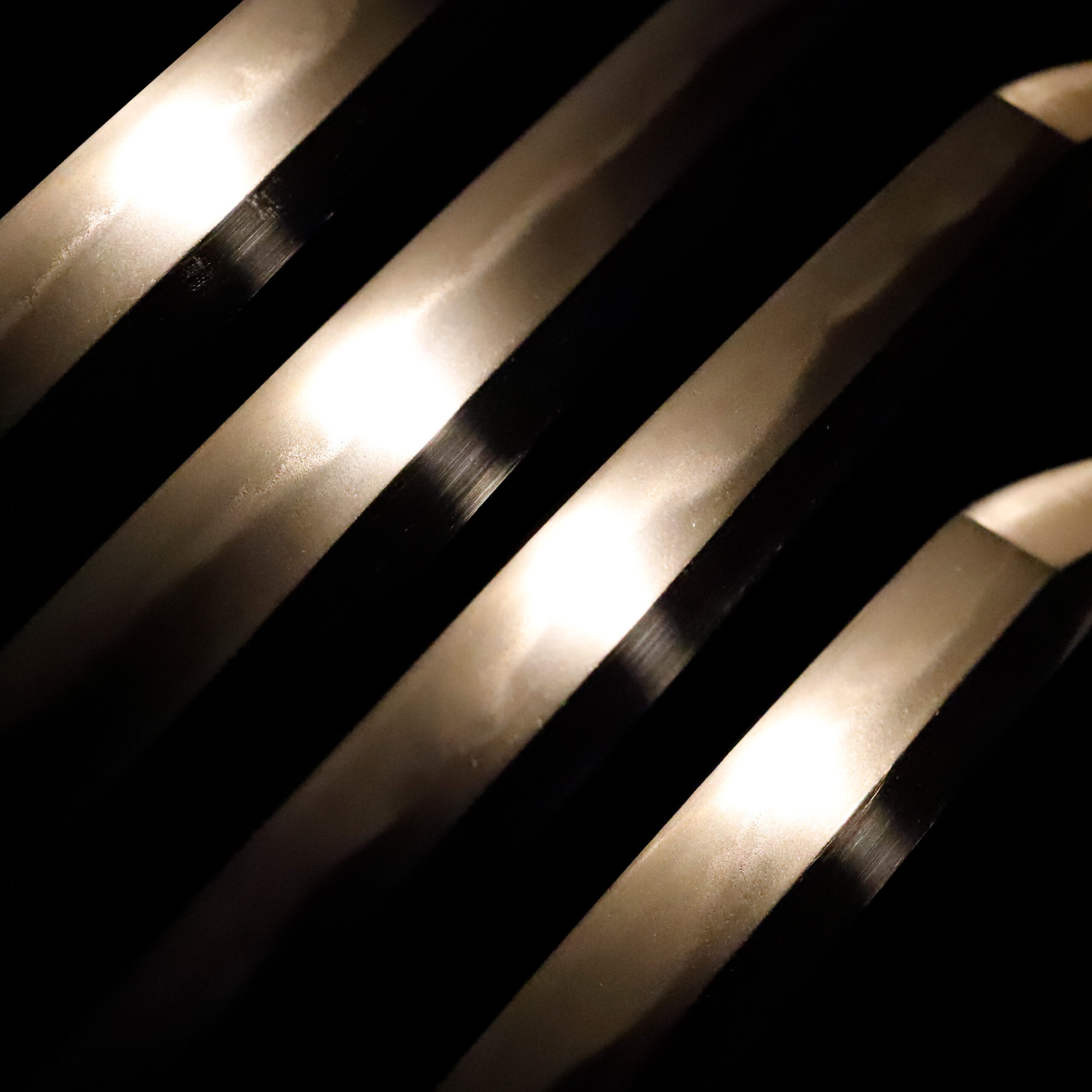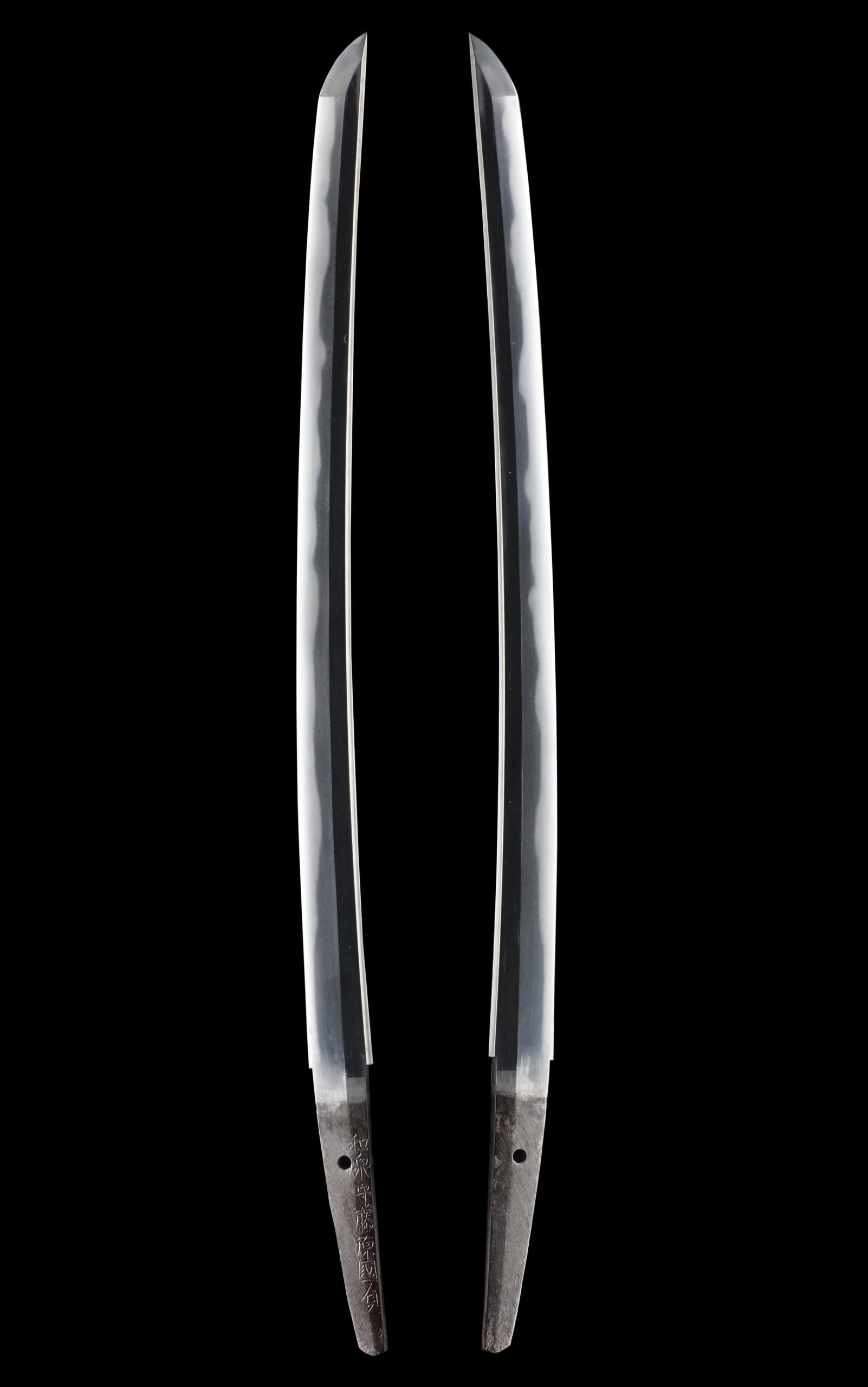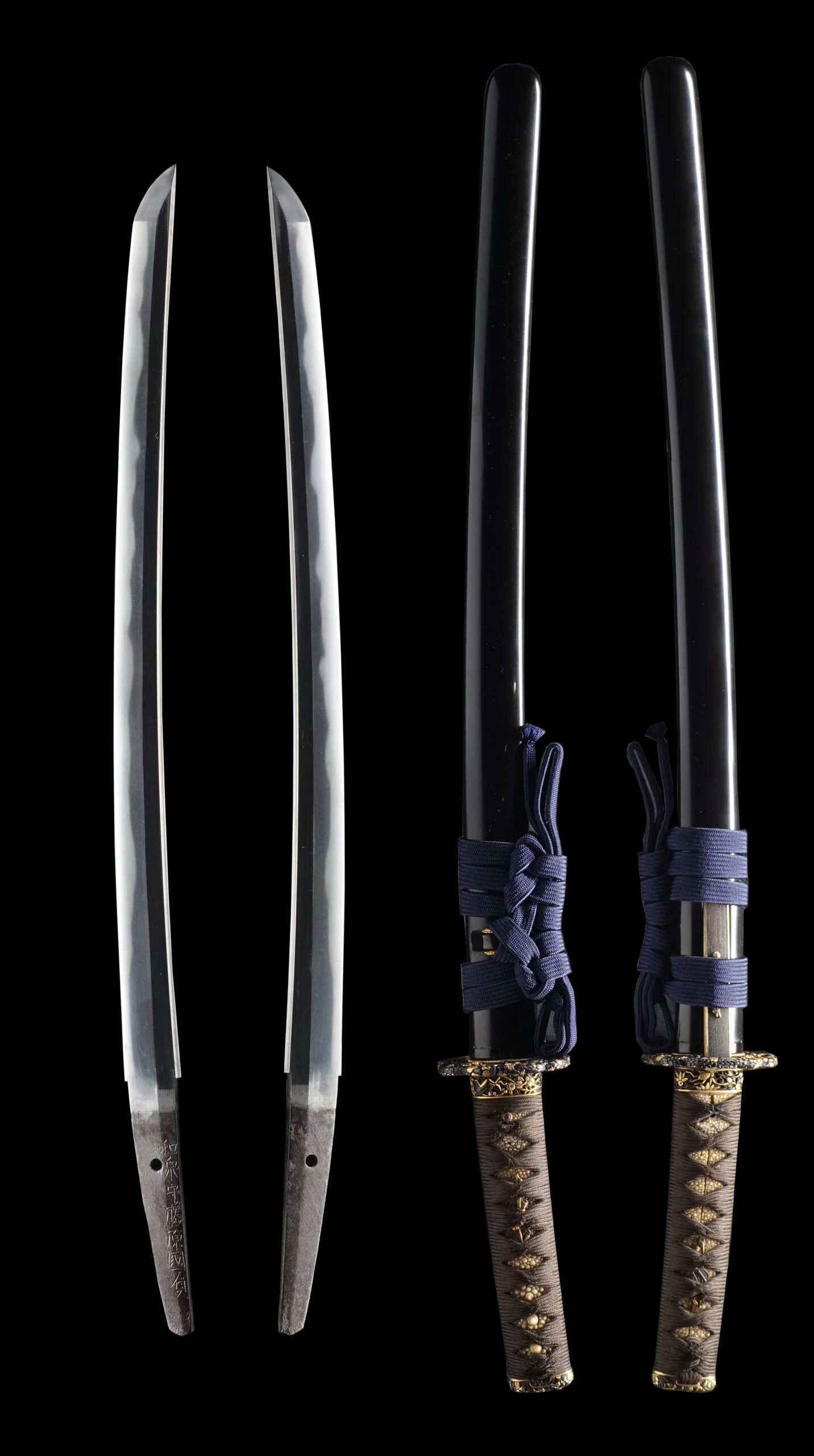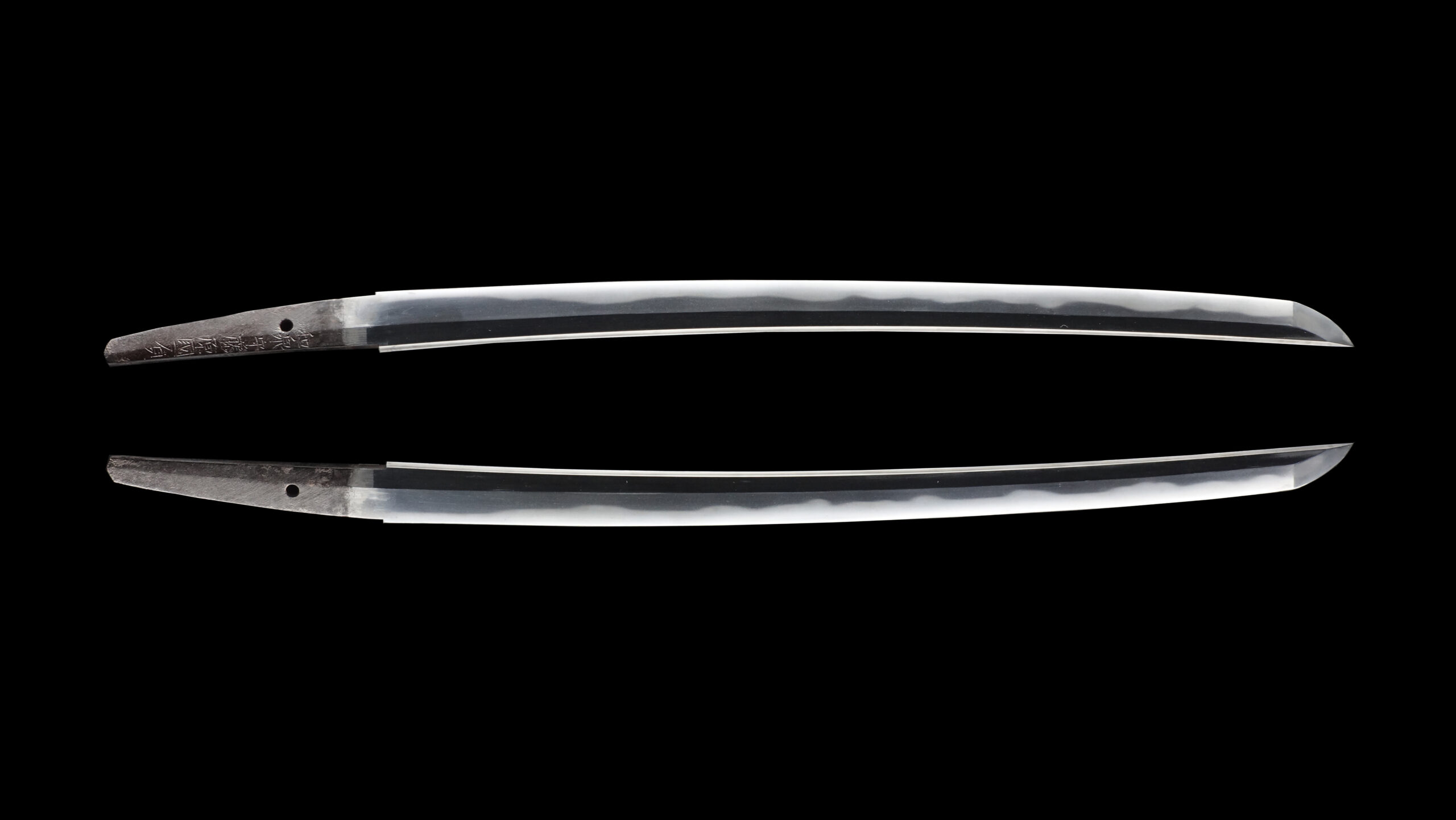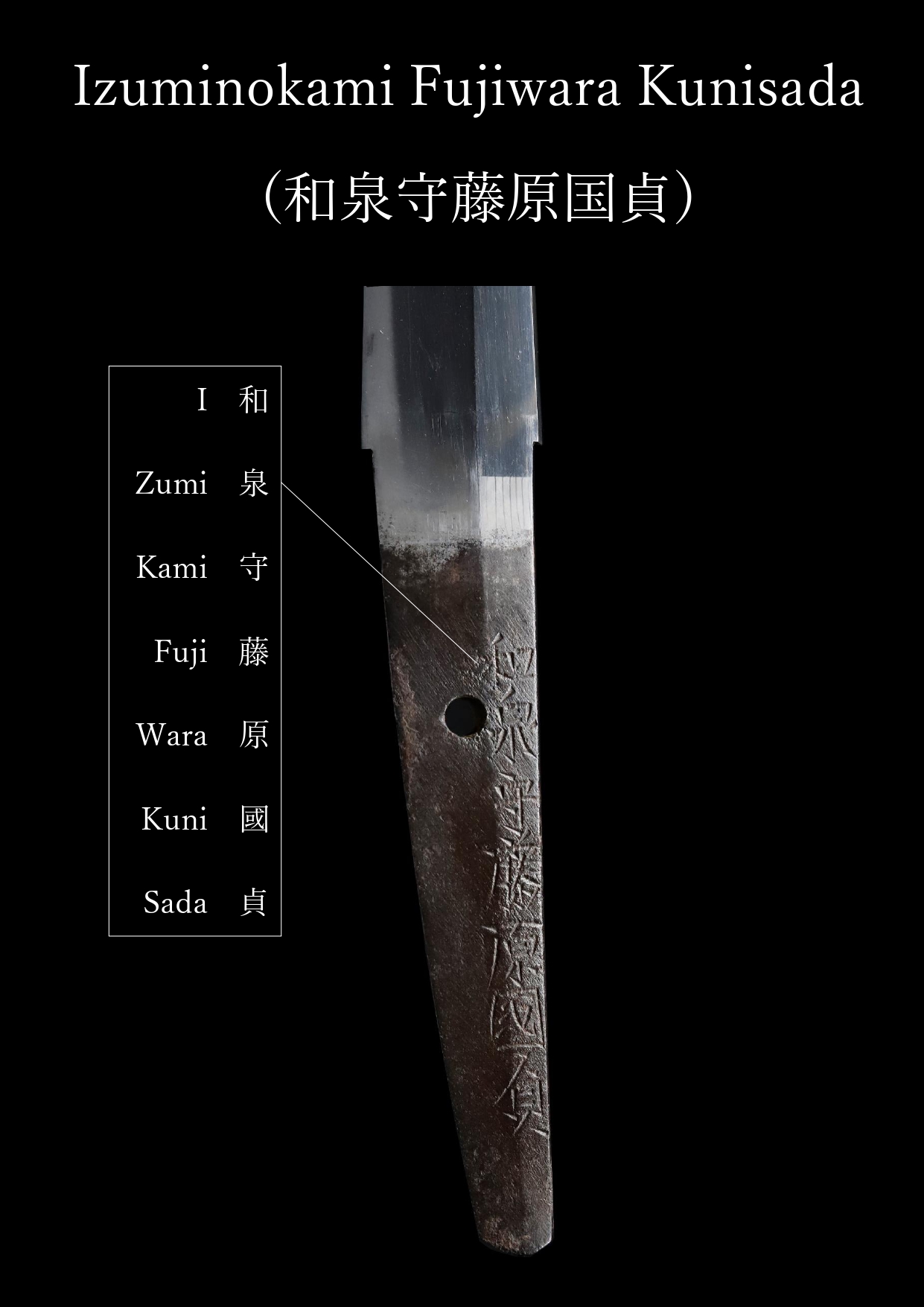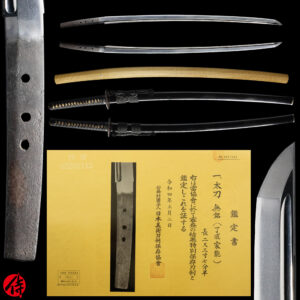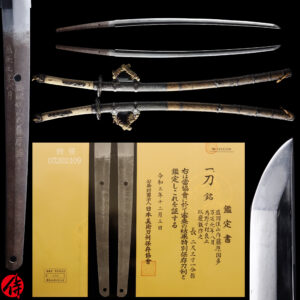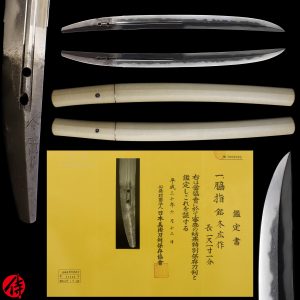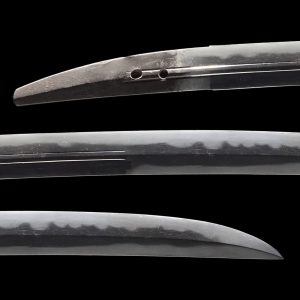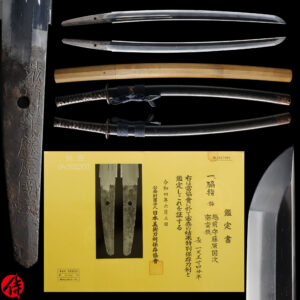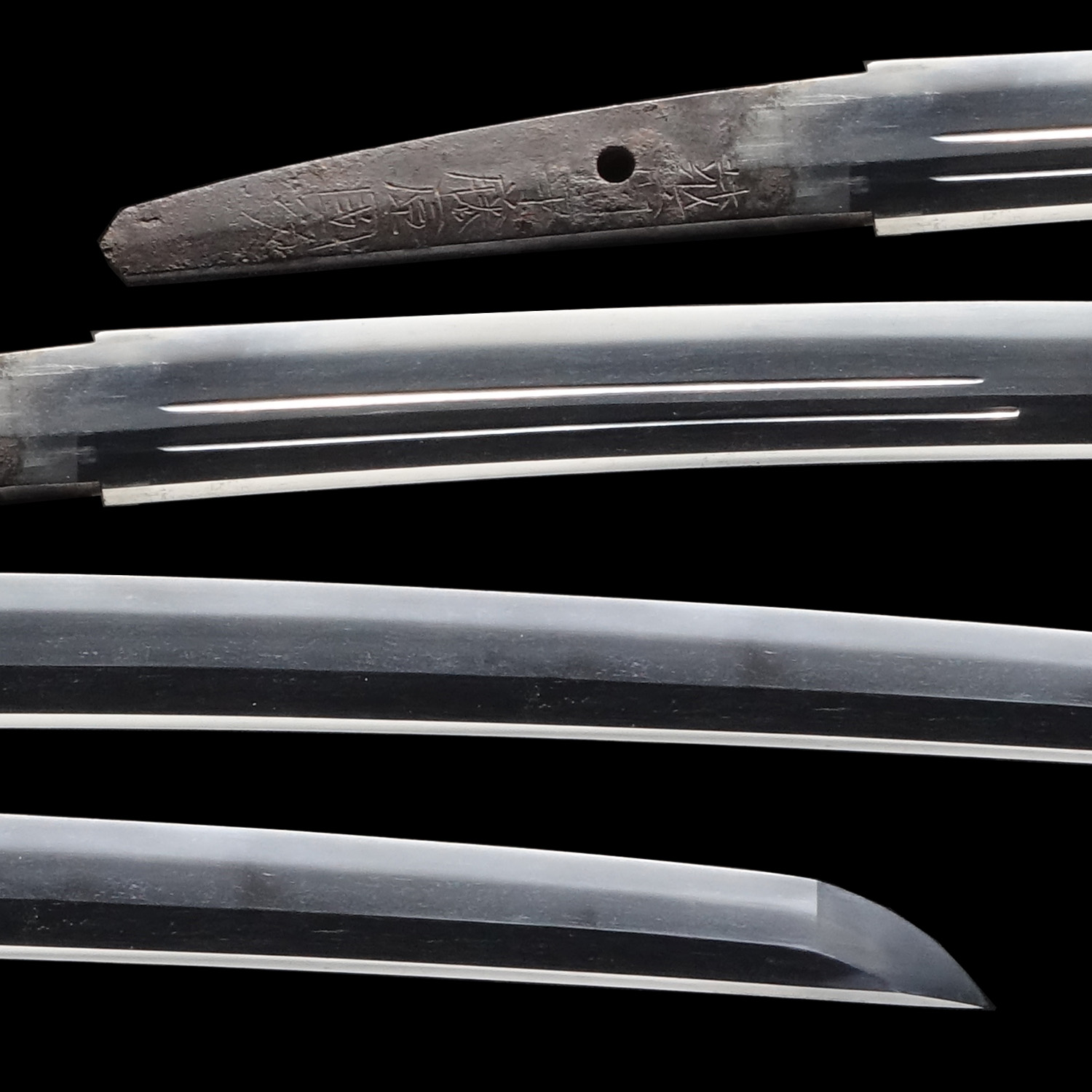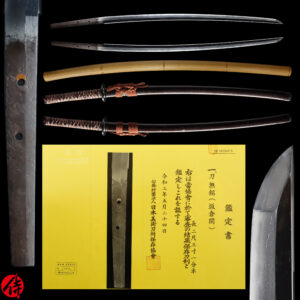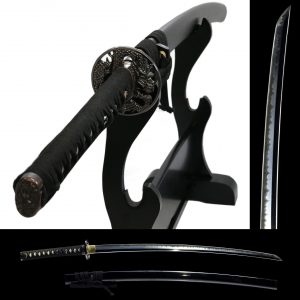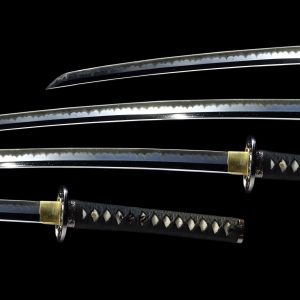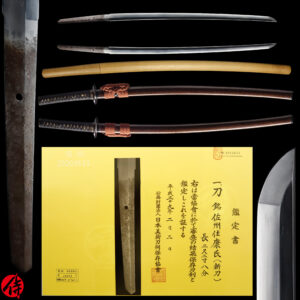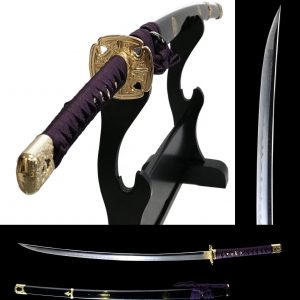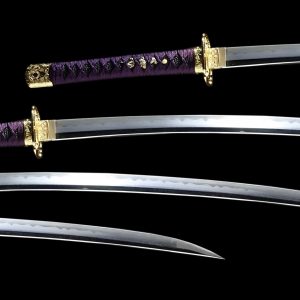Antique Japanese Sword Wakizashi Signed by Izumi no Kami Kunisada with NBTHK Tokubestsu Hozon Certificate
【Description】
Summary
Kunisada (国貞) split the popularity of the Osaka Shinto (大阪新刀) with the master Sukehiro (助広). He was born as the second son of Izuminokami Kunisada (和泉守国貞), who is famous as the founder of Osaka Shinto.
By 1650 (3rd year of Keian; 慶安), the second generation Kunisada had already completed many works on behalf of his father because of his old age. And in 1652 (the first year of Jouo; 承応), he received the title of Izuminokami (和泉守). In 1661 (4th year of Manji, 万治), the Imperial Court granted permission to use the 16-leaved chrysanthemum crest.
After that, Kunisada carved his engraved inscription as “Inoue Izuminokami Shinkai (井上和泉守真改),” but changed it to “Inoue Shinkai (井上真改)” from August 1672 (12th year of Kanubun; 寛文). Since his father also used the name Kunisada, the swords of the first Kunisada are sometimes called the Oya Kunisada (親国貞), and the sword that the second Kunisada forged are called the Shinkai Kunisada (真改国貞) to distinguish between the two.
Izumi no Kami Kunisada (His father)
Kunisada, also known as Inoue Yoshihiro, was born in the 17th year of Tensho era(1589) in the southern part of Miyazaki prefecture(Kyushu island). Later on, he moved to Kyoto and became an apprentice of Horikawa Kunihiro, one of the most famous swordsmiths in the early Edo period(early 17th century). He also learned the sword-forging technique from a senior apprentice, Echigo no Kami Kunitomo. Kunisada moved to Osaka in 1620 after his master, Kunihiro, was deceased. He became an independent swordsmith in Osaka city.
He was trusted by the third-gen head of Obi domain(Miyazaki prefecture), Ito Sukehisa, and Kunisada was able to receive the title of Izuminoakami in 1623 because of Sukehisa’s support.
He is known as one of the most influential swordsmiths to make Osaka a famous place for sword-forging in the early Edo period. Osaka was the center of business back then. Many renowned swordsmiths moved to Osaka to meet the demand from high-class Samurais.
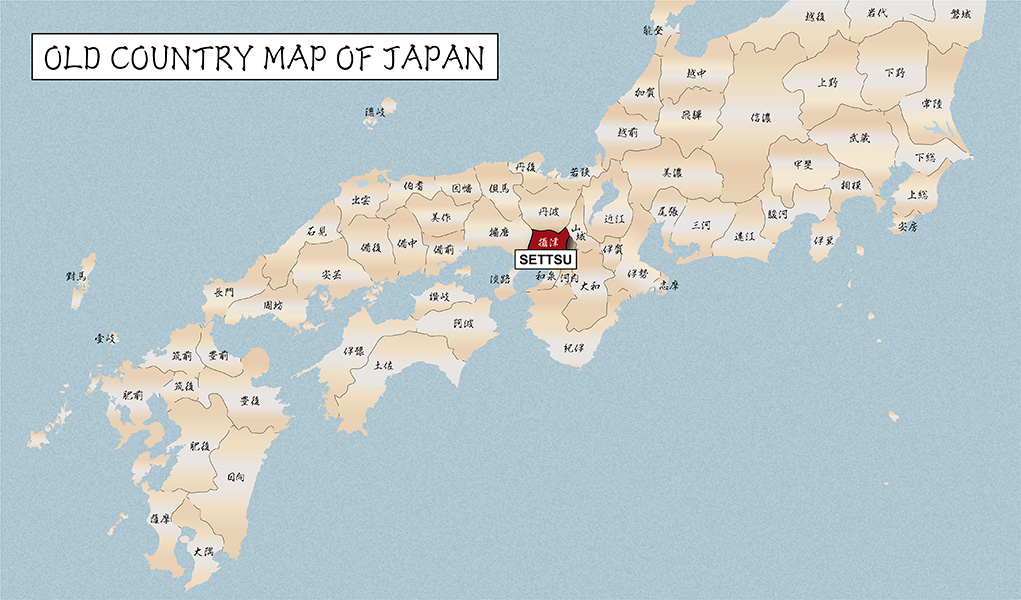
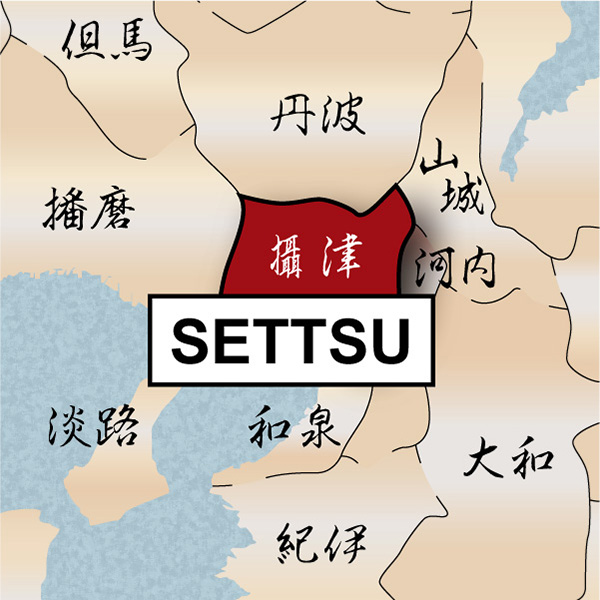
Osaka Shinto
The Shinto (新刀) is Japanese sword terminology referring to swords forged from 1596 to 1781. The blades made in the Osaka area during this period are called the Osaka Shinto (大阪新刀). There are many famous swordsmiths in this Osaka Shinto era. After Toyotomi Hideyoshi (豊臣 秀吉) built the Osaka castle, Osaka city flourished as a castle town and became the business center. Many swordsmiths moved to Osaka to look for better opportunities. They not only forged swords for those Samurai who lived in Osaka but also for feudal lords nationwide. Ikkanshi Tadatsuna (一竿子 忠綱, Awataguchi Ohmi no Kami Tadatsuna), Inoue Shinkai (井上 真改), and Tsuda Sukehiro (津田助広) are the most famous among many swordsmiths.
One of the most notable characteristics of Osaka Shinto is its beauty in Jigane (地鉄). Jigane is a visible steel surface pattern created by folding and hammering during the forging process, which made it possible by the location of Osaka. Osaka had close access to the production sites of the Tamahagane (玉鋼, special carbon steel to make Japanese swords). The swordsmiths residing in Osaka could get high-quality carbon steel from these sites.
This blade is appraised as a Tokubetsu Hozon Token(特別保存刀剣) issued by NBTHK(Nihon Bijutsu Touken Hozon Kyokai:日本美術刀剣保存協会). This authentication paper was only given to authentic Japanese swords, especially well preserved and high quality with artistic value.
【Blade】
Cutting Edge Length(Nagasa): 47.0 cm ( 18.5 inches)
Curvature(Sori):0.91 cm ( 0.36 inches)


Hamon:
The crystalline structure which forms along the cutting edge of a blade as a result of the hardening process
Jimon(Jihada):
visible steel surface pattern created by folding and hammering during forging process
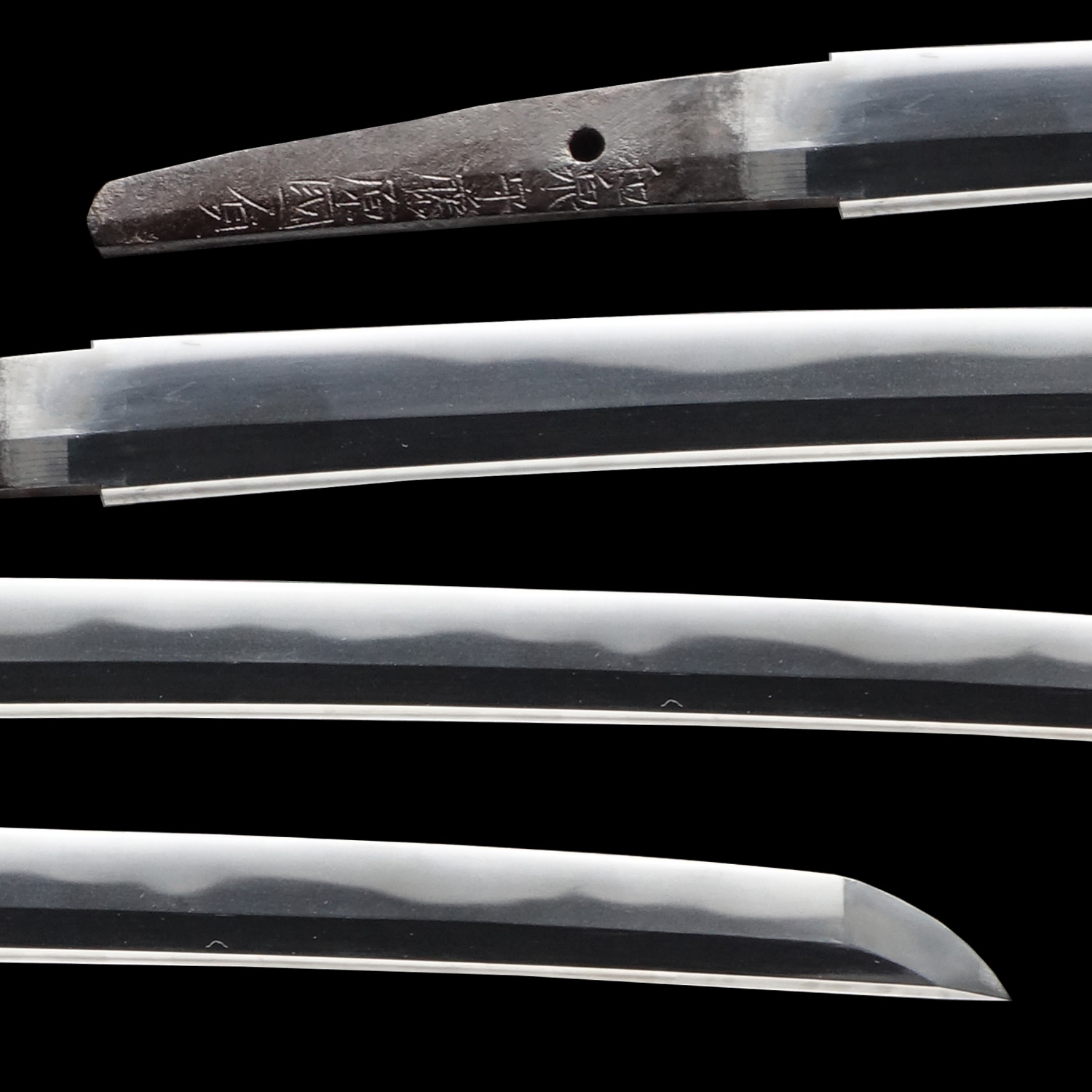
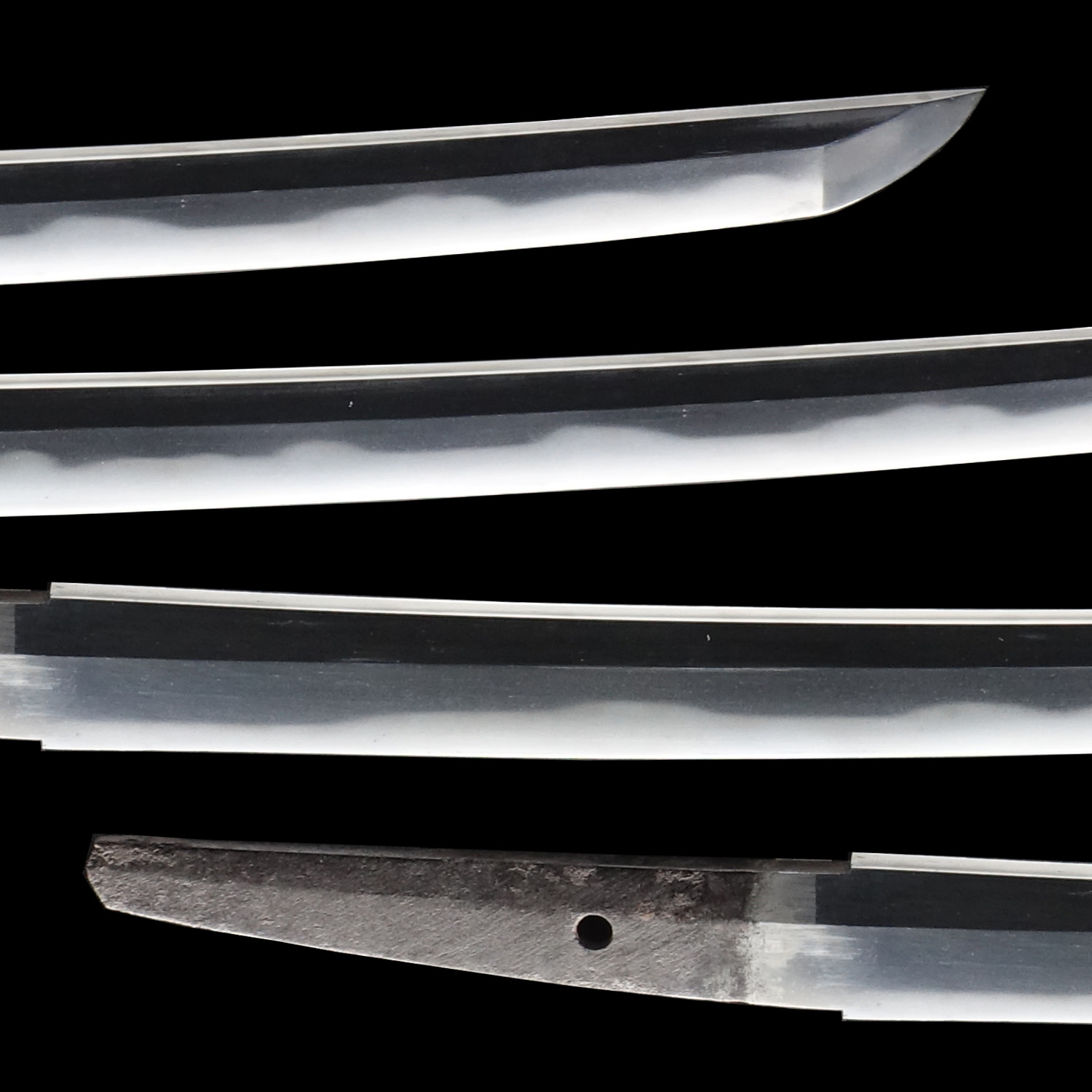

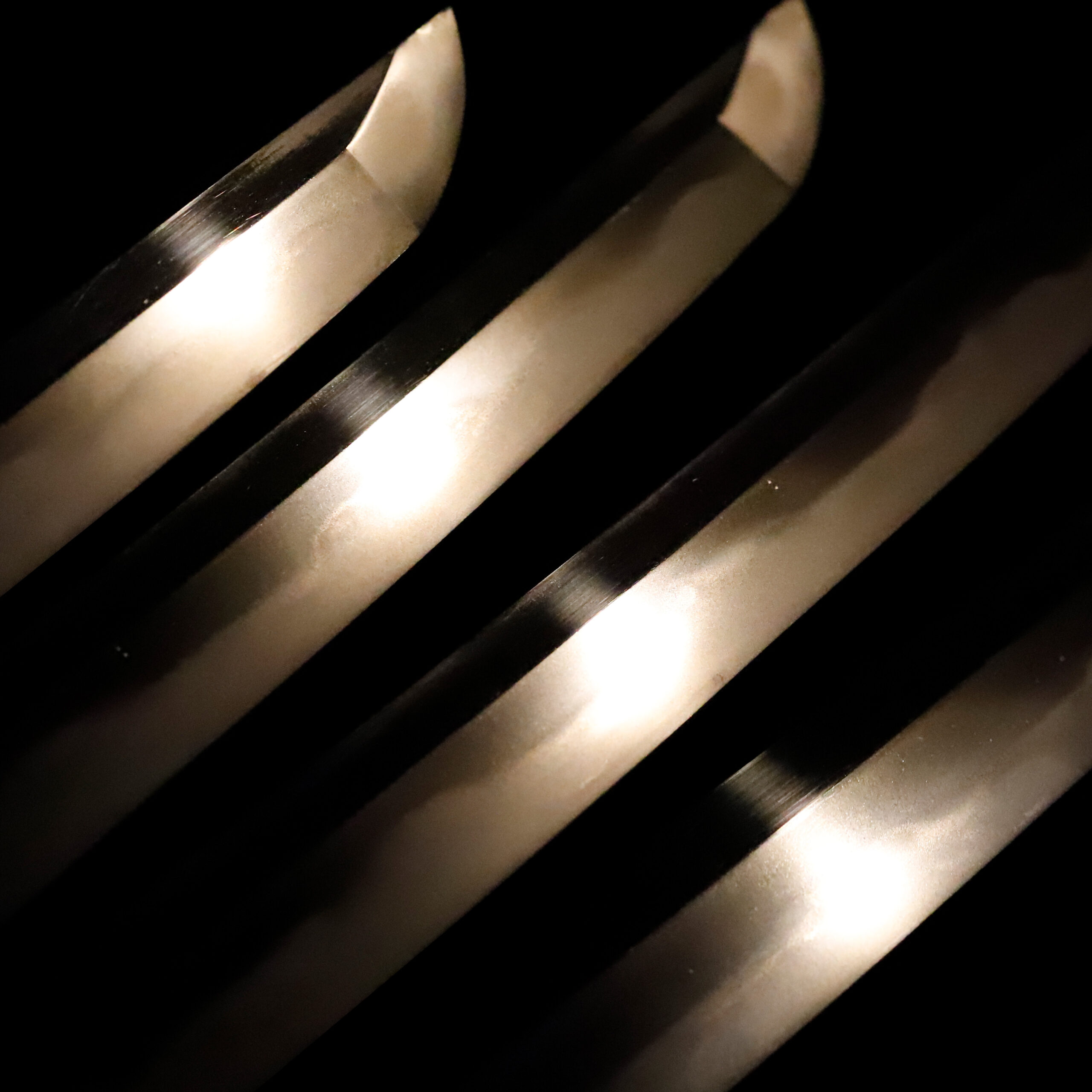
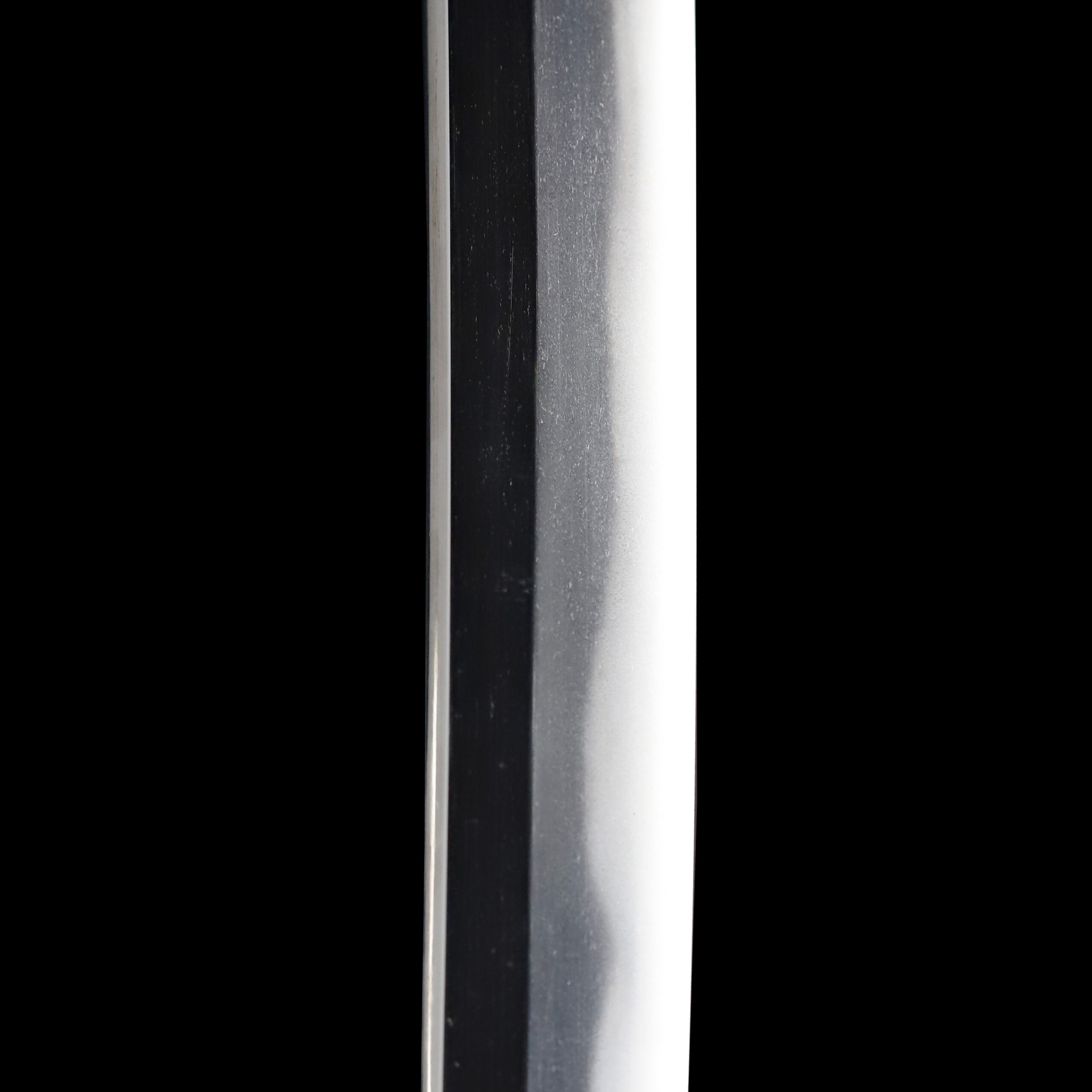
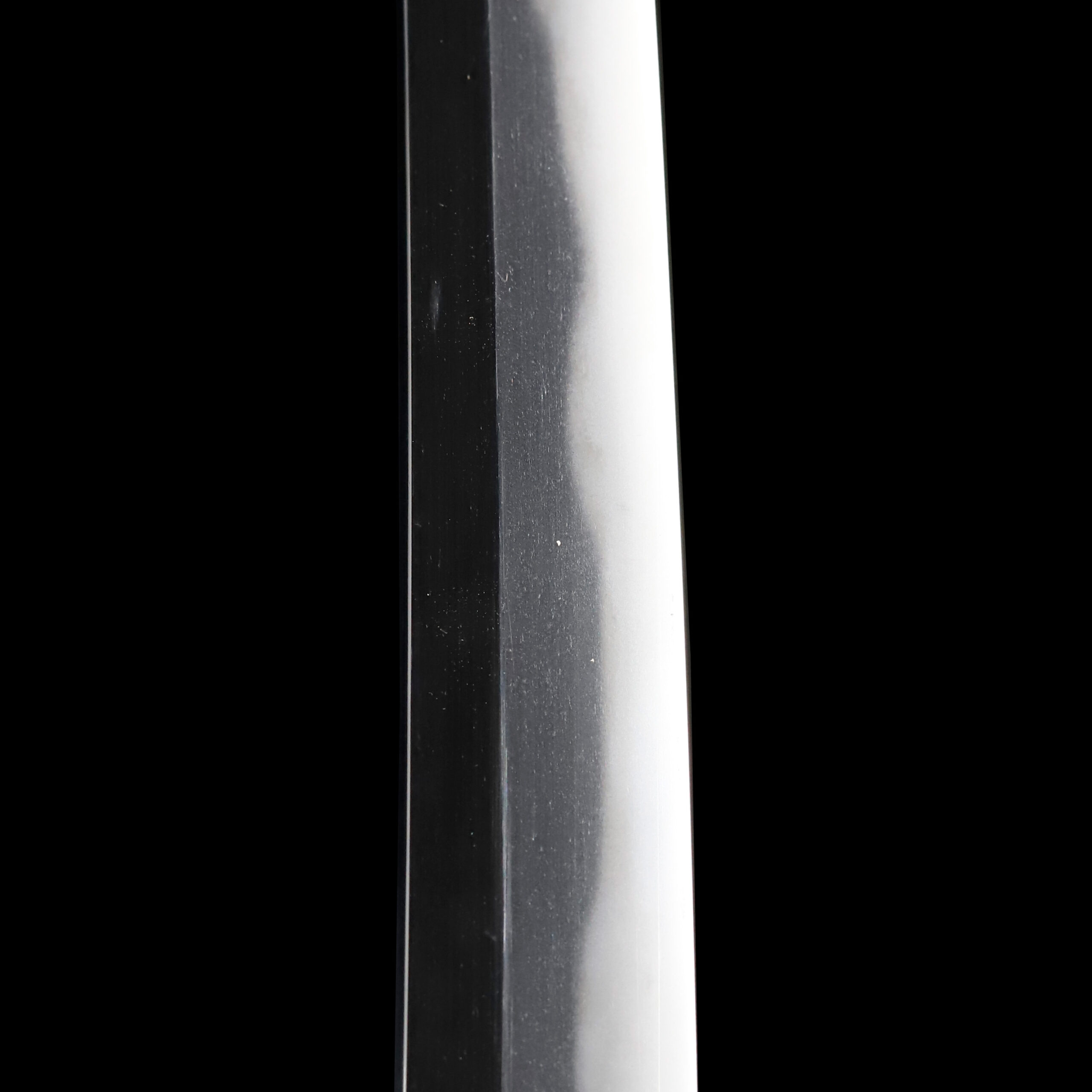
Nakago:Nakago is the tang of the Japanese sword.
Japanese swordsmiths left the black rust on the tang because it prevents red rust while the tang is in its handle. And the discoloration of the tang was created over time, and it is a great indicator for a Japanese sword specialist to estimate when the sword was forged.

Koshirae: Koshirae is the mounting of the Japanese sword. There are several parts that consist of Koshirae such as Saya(Scabbard), Tsuka( Handle), Tsuba(Handguard).

Fuchi-Kashira:A pair of matching sword fittings that cover the upper and bottom parts of its sword hilt.
This Fuchi Kashira is decorated with autumn motifs. You would find the figures of several insects between plants. In particular, we could find crickets, which are seasonal words of this season. Also, among these insects, the one which is depicted with a large body is a mantis. Mantis is also called “Ogami-Mushi (拝み虫, praying insect)” or “Inori-Mushi (祈り虫)” in Japanese. Both of these names mean a praying insect. Mantises hold their arms together, and their long wings cover their lower bodies. As this posture looks like a priest who prays to God, the mantis is likened to a “praying insect.”
Because the mantis lays many eggs at once, it is also seen as a lucky charm that symbolizes fertility. This Fuchi Kashira has a seasonal design that incorporates plenty of autumn motifs. However, we believe it is even more interesting to appreciate the meaning of these meanings (whether or not they were actually incorporated with that meaning in mind) when you enjoy seeing Koshirae.

Tsuka and Menuki:Tsuka is the handle of the Japanese sword and Menuki is its decoration.
Samurai-related items are incorporated into the design of this Menuki. The upper side Menuki is a combination of Gunbai (軍配) and bow. And another Menuki is probably a combination of flag and bow. Bows and arrows were primary weapons for Samurai warriors until the advent of guns. Therefore, it is understandable to be designed for sword mountings, as seen on this Menuki.
A Gunbai, its shape is an Uchiwa (団扇, Japanese fan) shape. The fan was brought to Japan from the continent in the Nara period (710-794). A theory says that Uchiwas were used in the court or the aristocracy back then. In addition, after the Ohnin-Bunmei era (応仁・文明年間, 1467-1487), military commanders used Gunbai-Uchiwa (軍配団扇), which is made of leather or iron. They encouraged their subordinates by using it. Also, it was used for ordering the arrangement of an army: For example, the placement of troops, the date and time of the advance, and retreat. It is the origin of the Gunbai, which Sumo (相撲, Japanese wrestling) referees use to judge victory or defeat.


Tsuba and Habaki:Tsuba is the handguard for the Japanese Sword and Habaki is the equipment to make the blade not touch its scabbard inside. It prevents the blade from getting rusty and chipped.
This Tsuba has an ornamental appearance. The Mimi (耳, edge of Tsuba) seems to be decorated with autumn wildflowers, mainly chrysanthemums. However, here, we would like to focus on the animal motifs.
We estimate these animals were chosen here based on the idea of the Junishi (十二支, the twelve signs of the Chinese and Japanese zodiacs). On the upper side of the front, you would find the figure of three animals who are members of this group: Ne (子, mouse), Ushi (丑, cow), Tora (寅, tiger). And on the lower side, there are U (卯, rabbit), Tatsu (辰, dragon), and Mi (巳, snake).
On the backside, the rest of the six animals are engraved: Uma (午, horse), Hitsuji (未, sheep), Saru (申, monkey), Tori (酉, chicken), Inu (戌, dog), Inoshishi (亥, boar). The zodiac has a fixed order; however, here, animals are not arranged according to that order. Therefore, it is speculated that this idea was partially incorporated into this Tsuba’s design rather than strictly. In any case, it is a beautiful metal work with a gorgeous appearance.

Kozuka:Kozuka is a small knife stored in Kozuka Hitsu(groove of the sheath of the Japanese sword).
A Kogatana (小刀, small knife) is sorted into the Kozuka. The surface of this Kozuka is decorated with the Nanako-Ji (魚子地) technique. This process makes a uniform minimal protrusions pattern by hitting the Nanako-Ji Tagane (魚子地鏨, a chisel for this technique) on a metal surface. This decorative technique is often seen on sword mountings. About the design, a kind of flower is engraved and colored with gold. Same as the Fuchi Kashira and Tsuba mentioned above, this Kozuka’s design also has a similarity based on its motif.

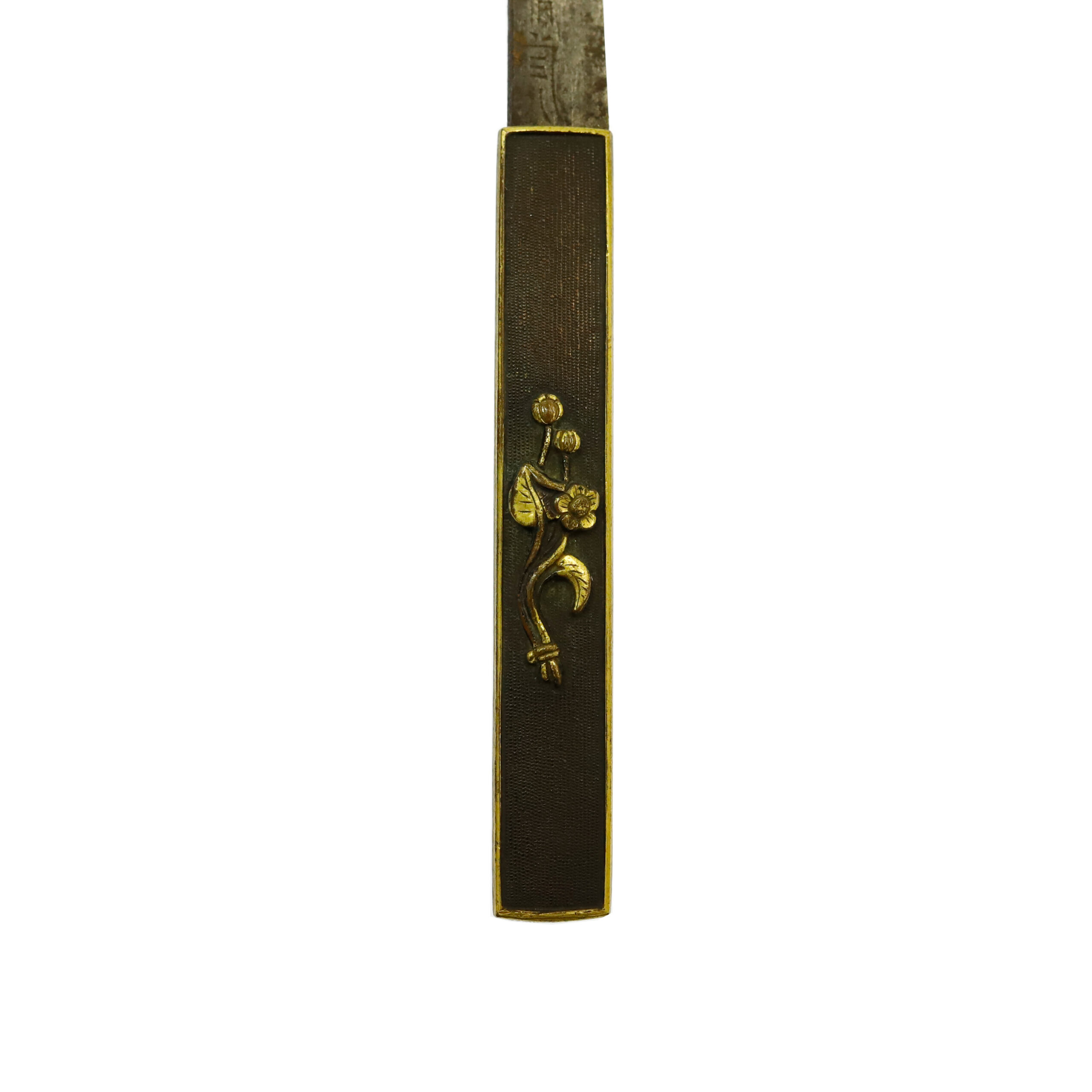
Saya: Saya is the scabbard for the Japanese sword.

Authentication Paper:NBTHK Tokubetsu Hozon Certificate for the blade (No.1019501)
NBTHK, also known as Nihon Bijutsu Touken Hozon Kyokai (the Society for the Preservation of the Japan Art Sword), is one of the oldest Japanese sword appraising organizations in modern-day Japan. They authenticated the blade on Dec 14th in the 4th year of Reiwa(2022). They appraised it as Tokubetsu Hozon Touken, the blade especially worth preserving for Japanese society. The purchaser will receive this original certificate as well. We can also translate what is written into English and make a PDF file for your record if you request.

Registration Number : Miyazaki 1831
The Board of Education in Miyazaki prefecture issued a registration paper for this sword. It is called Jyu Token Rui Torokusho(銃刀剣類登録証). Bunkacho(The Agency for Cultural Affairs) acknowledges a Japanese sword with this paper as a work of art.
The sword needs to be traditionally hand-forged and made of Tamahagane carbon steel to be registered in the system. With this paper, its owner in Japan can legally own an authentic Japanese sword. Based on this registration number, we will apply for its export permit.
This paper will need to be returned to the board of education when the sword is being shipped abroad, but you can receive a copy of it. An English translation of this registration paper is available on request.
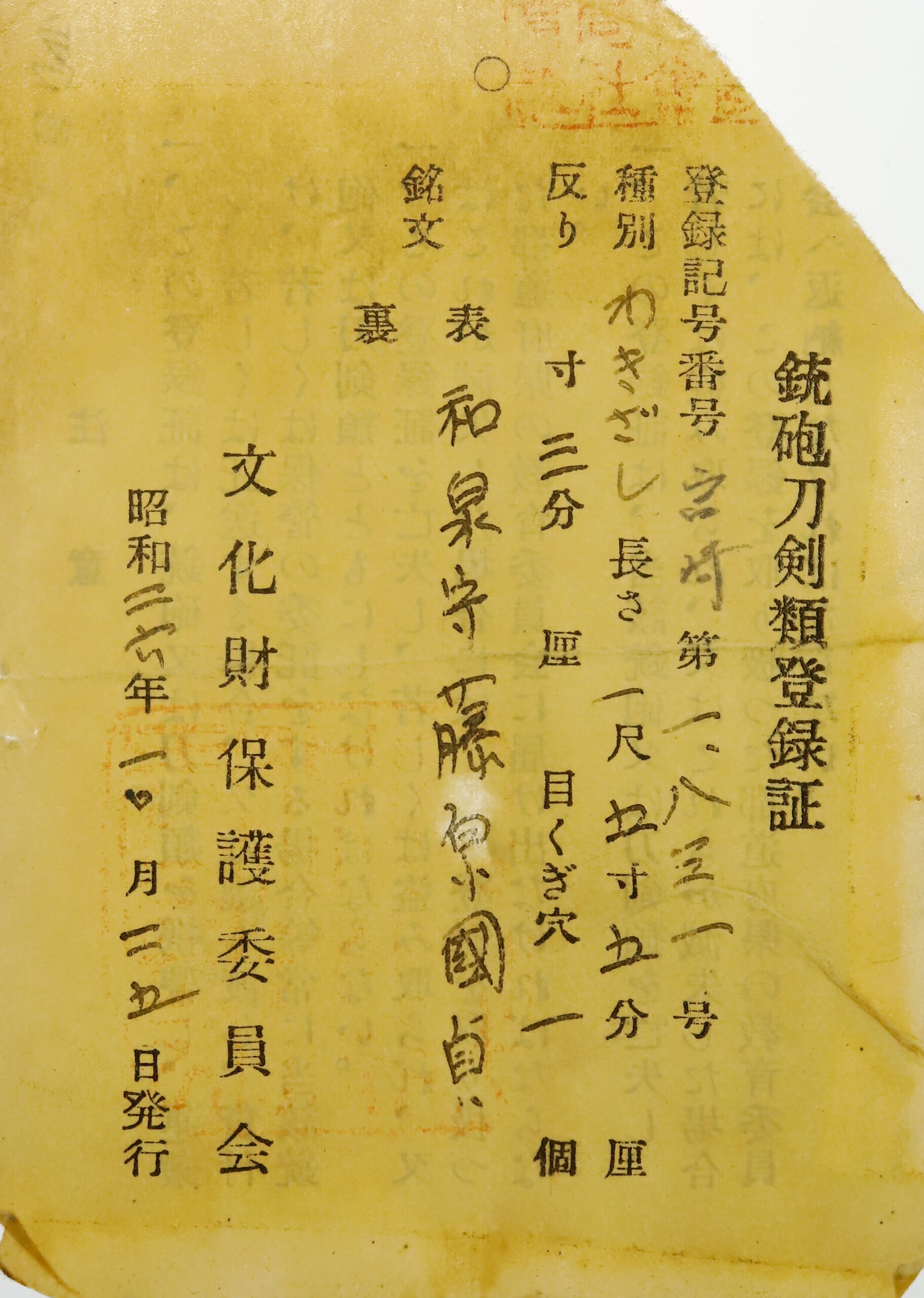

—————————————————————–
【About us】
Samurai Museum is located in Tokyo, Japan, exhibiting antique artifacts related to the Samurai history. Samurai Museum Shop is the place for those who are interested in Japanese culture and craftsmanship. We deal with antique Samurai swords/armor, traditional crafts made in Japan and so on.
【Review】
Here is one of the reviews we received from a customer who purchased an authentic Japanese sword from us. For more reviews, please click here.
“My experience overall with the whole process was wonderful. I had many questions about the history and process to purchase these treasures. All my questions were answered very timely and complete. The staff is very knowledgeable and very well versed if any questions do arise.”
【Japanese Sword& Export Process】
The Japanese swords we deal with are hand-forged edged swords made in Japan. It was made from the traditional carbon steel called TAMAHAGANE(玉鋼). Samurai Museum is familiar with the proper legal procedure for an antique/ authentic Japanese sword to be exported from Japan. We have sent more than 500 Japanese swords for the past three years (~2023) to amazing owners who appreciate its historical value.
Each Japanese sword is registered under the Agency for Cultural Affairs and the Board of Education in Japan. They issue a registration paper for each Japanese sword for its owner in Japan to legally possess it. The Japanese sword with its registration paper means it was traditionally hand-forged in Japan.
To legally export the sword from Japan to other countries, we will have to apply for its permit to the Agency for Cultural Affairs(Bunkacho) and return the original registration paper to the Board of Education. It normally takes around 2-4 weeks to receive this permit after submitting required documents. And we would like you to expect at least 1-1.5 months for your order to arrive at your given address after you ordered. For more detailed info, please click here.
It is allowed for residents in Japan to own authentic Japanese swords without a special license as long as they come with registration papers. Please feel free to contact us if you are a resident of Japan, whether temporarily or permanently. We will also assist you when you leave Japan and need to obtain the export permit.
【Payment Method】
We accept payment through Stripe (Credit card), PayPal, Apple Pay or ChromePay, all of which are secure payment methods. Also, you don’t need to make an account on Stripe for the checkout. If you prefer other payment method, please contact us. After confirming your payment, we will apply for an export permit. You may either pay in JPY, USD, AUD, CAD,EUR CHF or GBP. The price is set in Japanese Yen. Prices in other currencies are automatically calculated based on the latest exchange rate.

* If the amount is above 1 million JPY, Stripe or wire transfer will be the only options for payment.
【Shipping】
We have shipped authentic Japanese swords to the USA, UK, Canada, Mexico, Germany, Switzerland, France, Hong Kong and Australia. If you don’t live in these countries and like to order, please contact us first before making a purchase. We offer Free International Shipping as long as we can send antique Japanese swords by EMS.
We normally ship by EMS(Express Mail Service) provided by Japan Post. We will send you a tracking number for your order as soon as we hand it to the post office. We will put 100 % insurance on the shipping document without any extra charge. Based on the total amount, there might be a duty tax or other fee for you to pay, depending on the countries. We use package cushioning to protect the item and put it in a PVC pipe, which is one of the most secure packages because of its durability.
It will normally takes 5-14 days for the item to arrive at your given address after we dispatch it. Time of delivery is estimated as accurately as possible by the carrier but does not take into account any delays beyond our control such as by inclement weather, post office holiday seasons.
* If you live in Australia and like to purchase an authentic Japanese sword, please click here to know the detail.
*Please keep in mind that due to the spread of COVID-19, there might be delays in shipping. If you like to know the detail about shipping, please feel free to ask us.

【How to make sure the condition】
Please keep in mind that what you are going to purchase is an antique item. We uploaded high resolution photos for you to check its condition thoroughly. If you like to see more photos with different angles, please feel free to contact us. We will be happy to send them to you so that you can make informed decision. It is essential for us to know that you are happy with your choice of a sword. and we are prepared to use the best of our ability to serve you.
【How To Contact Us】
Please contact us through email, Facebook Messenger or Live Chat if you have any questions. You can find each icon on the right side of the website. Please click one of them to reach us. We will reply to you within 1-2 business days.
【The Art of Nihonto(Japanese Sword)】
Samurai’s history is a profound, eloquent legacy of ancient Japanese warriors in which millions of people worldwide are being fascinated. If you like to find out the art of Nihonto, please click here.
【A Guide to Japanese Sword Maintenance】
After acquiring an genuine Japanese sword, it is also important to know how to take good care of it. Here is the special video for you. Mr. Paul Martin, Japanese sword expert, shows you how to give proper maintenance to your sword. By mastering how to clean the Japanese sword, its aesthetic beauty will last forever.
When you purchase a Japanese sword from us, you can get a Free Japanese sword maintenance kit. It comes with four tools(Choji Oil, Uchiko Whetstone Powder, Peg remover, Oil Applicator). By watching the video instruction above , you can enjoy learning how to maintain your Japanese sword while appreciating it. If you have any difficulty assembling the sword or cleaning the blade, you can feel free to contact us.


MORE ANTIQUE JAPANESE SWORD FOR SALE
SWORDS WITHOUT CERTIFICATES FOR SALE
LEARN JAPANESE SWORD TERMINOLOGY
Thank you for reading all the information on the page. If you have any difficulty choosing the right Japanese sword for you, we will be more than happy to help you find the one that speaks to you the most. Please feel free to contact us.
